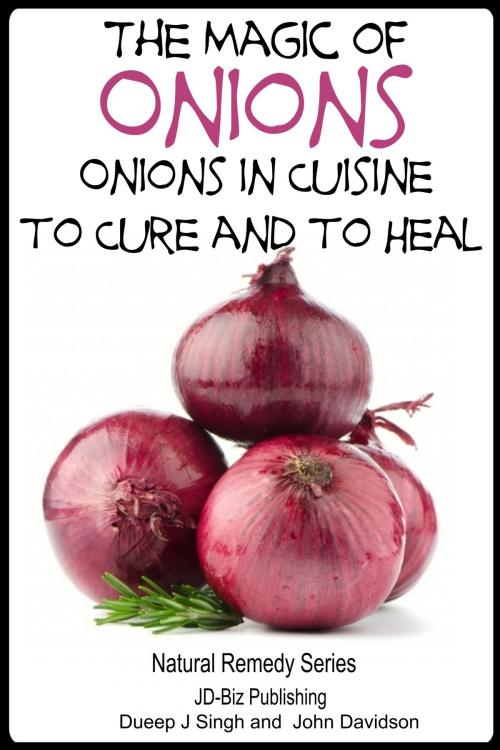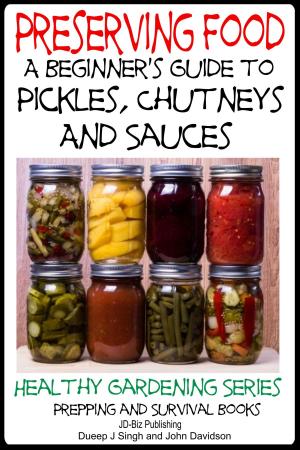The Magic of Onions: Onions in Cuisine to Cure and to Heal
Nonfiction, Health & Well Being, Health, Alternative & Holistic Health, Herbal Medications, Food & Drink, Vegetables & Salads| Author: | Dueep Jyot Singh, John Davidson | ISBN: | 9781311877574 |
| Publisher: | JD-Biz Corp Publishing | Publication: | February 26, 2014 |
| Imprint: | Smashwords Edition | Language: | English |
| Author: | Dueep Jyot Singh, John Davidson |
| ISBN: | 9781311877574 |
| Publisher: | JD-Biz Corp Publishing |
| Publication: | February 26, 2014 |
| Imprint: | Smashwords Edition |
| Language: | English |
The Magic of Onions - Onions in Cuisine to Cure and to Heal
Table of Contents
Introduction – Knowing More about Onions
Perfect Salad Recipe
How to Grow Onions
Planting an onion
How and When To Harvest Onions?
Traditional Onion Recipes
Traditional Onion Soup
Croutons
Cream of Onion Soup
Curry Powder Recipe
Traditional chicken – Meat stock with onions
Traditional Onion Pickle
Kashmir Spice Mix
Garam Masala Recipe
Meat Doh Pyazah-Literally Meat Two Onions.
Traditional Onion Mixed grain Bread
Farmers Onion Chutney
Traditional Buttermilk
Sweet and Sour Onions – French Style
Clarified Butter
How to dry onions
Conclusion
Author Bio
Introduction – Knowing More about Onions
Is there really Magic in onions, you may say, because according to you, onions are those sharp and pungent smelling, vegetables, which you normally do not allow within smelling distance of your nose and kitchen?
It is possible that you have been brought up with a feeling that onion and garlic – those odoriferous pungent smelling herbs are not acceptable in select circles. Did you know that the United States is the third-largest producer of onions in the world – after China and India, and followed by Egypt, Iran and Turkey.
But then there was a time when onions grew – and still grow – wild all over the lands of the USA and Canada. The Native Americans enjoyed wild onions and the Pilgrim fathers planted the onion plant first and foremost, before corn, on American soil in 1658. That was because they knew a freshly pulled out onion from their garden added this bit of piquancy to their meals.
The onions eaten by men more than 5000 years ago, according to archaeological findings may have been wild onions, but 3000 years ago, Egyptians were writing about cultivated onions and the important part this healing herb played in their food.
Egyptian workers building Khufu’s pyramids ate these onions along with horse radishes in copious quantities 3000 years ago. [Incidentally, they were not slaves. They were free Egyptians. A majority of them were farmers who were asked by Khufu and afterwards Ramses, Soser and other pharaohs to help build pyramids, during the seasons when the Nile was not in flood to help cultivate their fields. So instead of sitting idly in their fields, they glorified in taking part in the building of monuments, which would magnify the pride of Egypt, and their Pharaohs throughout the world.
There were no slave drivers with whips and lashes to make them sweat, whatever Mr. Cecil DeMille may want us to think. The diet of these farmers /pyramid workers was onions with herbs and horse radishes, bread made up of freshly ground corn and beer. They did not mind spending a part of their year building pyramids for their Kings who appreciated their hard work by allowing them grain from the nation’s granaries.]
These Egyptians knew all about the value of onions, and worshiped them as a symbol of eternal life in many circles. Ancient Egyptians had onions placed on their eyes, before embalming or mummifying and burial, so that they could enter the circle of eternal life.
With daily portions of Onions, salt and herbs Roman soldiers were happy!
Roman soldiers also included onions in their diet, especially in the evenings, when they ate onions with red cayenne peppers and the salt they got as salary for the day’s work.
In medieval times, onions were held to be so precious in many parts of the world, that landlords demanded onions as rent in lieu of coin from their tenants.
The Magic of Onions - Onions in Cuisine to Cure and to Heal
Table of Contents
Introduction – Knowing More about Onions
Perfect Salad Recipe
How to Grow Onions
Planting an onion
How and When To Harvest Onions?
Traditional Onion Recipes
Traditional Onion Soup
Croutons
Cream of Onion Soup
Curry Powder Recipe
Traditional chicken – Meat stock with onions
Traditional Onion Pickle
Kashmir Spice Mix
Garam Masala Recipe
Meat Doh Pyazah-Literally Meat Two Onions.
Traditional Onion Mixed grain Bread
Farmers Onion Chutney
Traditional Buttermilk
Sweet and Sour Onions – French Style
Clarified Butter
How to dry onions
Conclusion
Author Bio
Introduction – Knowing More about Onions
Is there really Magic in onions, you may say, because according to you, onions are those sharp and pungent smelling, vegetables, which you normally do not allow within smelling distance of your nose and kitchen?
It is possible that you have been brought up with a feeling that onion and garlic – those odoriferous pungent smelling herbs are not acceptable in select circles. Did you know that the United States is the third-largest producer of onions in the world – after China and India, and followed by Egypt, Iran and Turkey.
But then there was a time when onions grew – and still grow – wild all over the lands of the USA and Canada. The Native Americans enjoyed wild onions and the Pilgrim fathers planted the onion plant first and foremost, before corn, on American soil in 1658. That was because they knew a freshly pulled out onion from their garden added this bit of piquancy to their meals.
The onions eaten by men more than 5000 years ago, according to archaeological findings may have been wild onions, but 3000 years ago, Egyptians were writing about cultivated onions and the important part this healing herb played in their food.
Egyptian workers building Khufu’s pyramids ate these onions along with horse radishes in copious quantities 3000 years ago. [Incidentally, they were not slaves. They were free Egyptians. A majority of them were farmers who were asked by Khufu and afterwards Ramses, Soser and other pharaohs to help build pyramids, during the seasons when the Nile was not in flood to help cultivate their fields. So instead of sitting idly in their fields, they glorified in taking part in the building of monuments, which would magnify the pride of Egypt, and their Pharaohs throughout the world.
There were no slave drivers with whips and lashes to make them sweat, whatever Mr. Cecil DeMille may want us to think. The diet of these farmers /pyramid workers was onions with herbs and horse radishes, bread made up of freshly ground corn and beer. They did not mind spending a part of their year building pyramids for their Kings who appreciated their hard work by allowing them grain from the nation’s granaries.]
These Egyptians knew all about the value of onions, and worshiped them as a symbol of eternal life in many circles. Ancient Egyptians had onions placed on their eyes, before embalming or mummifying and burial, so that they could enter the circle of eternal life.
With daily portions of Onions, salt and herbs Roman soldiers were happy!
Roman soldiers also included onions in their diet, especially in the evenings, when they ate onions with red cayenne peppers and the salt they got as salary for the day’s work.
In medieval times, onions were held to be so precious in many parts of the world, that landlords demanded onions as rent in lieu of coin from their tenants.















